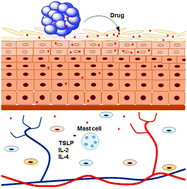Synthesis of poly(lactide-co-glycerol) as a biodegradable and biocompatible polymer with high loading capacity for dermal drug delivery†
Abstract
Due to the low cutaneous bioavailability of tacrolimus (TAC), penetration enhancers are used to improve its penetration into the skin. However, poor loading capacity, non-biodegradability, toxicity, and in some cases inefficient skin penetration are challenging issues that hamper their applications for the dermal TAC delivery. Here we present poly(lactide-co-glycerol) (PLG) as a water soluble, biodegradable, and biocompatible TAC-carrier with high loading capacity (14.5% w/w for TAC) and high drug delivery efficiencies into the skin. PLG was synthesized by cationic ring-opening copolymerization of a mixture of glycidol and lactide and showed 35 nm and 300 nm average sizes in aqueous solutions before and after loading of TAC, respectively. Delivery experiments on human skin, quantified by fluorescence microscopy and LC-MS/MS, showed a high ability for PLG to deposit Nile red and TAC into the stratum corneum and viable epidermis of skin in comparison with Protopic® (0.03% w/w, TAC ointment). The cutaneous distribution profile of delivered TAC proved that 80%, 16%, and 4% of the cutaneous drug level was deposited in the stratum corneum, viable epidermis, and upper dermis, respectively. TAC delivered by PLG was able to efficiently decrease the IL-2 and TSLP expressions in human skin models. Taking advantage of the excellent physicochemical and biological properties of PLG, it can be used for efficient dermal TAC delivery and potential treatment of inflammatory skin diseases.



 Please wait while we load your content...
Please wait while we load your content...